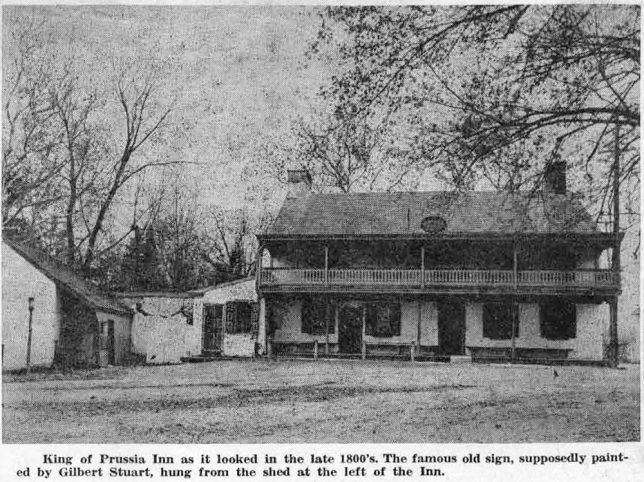 Public interest in the future of the old King of Prussia Inn has been stirred anew in this area by recent newspaper reports that construction will begin shortly on a Howard Johnson restaurant at the northeast corner of Route 202 and 23, in the center of the King of Prussia area.
Public interest in the future of the old King of Prussia Inn has been stirred anew in this area by recent newspaper reports that construction will begin shortly on a Howard Johnson restaurant at the northeast corner of Route 202 and 23, in the center of the King of Prussia area.
This newest link in the restaurant chain will cost $100,000, and is scheduled to be completed by April 1, with a seating capacity of 88. The site for this building will be the Alexander H. Crockett property, on which another historic building already stands. Possible demolition of this building is one of the motivating factors for a group of interested neighbors in Montgomery County to seek a temporary injunction against the erection of the new structure.
This is but another angle to the general problem created by the transformation of the comparatively quiet crossroads of yesterday by today’s introduction of feeder highways to the Pennsylvania Turnpike and the Schuylkill Expressway, with the fate of the historic King of Prussia Inn the main matter of concern. This old inn, which is now left standing on the island between Routes 202 and 23, was recently sold to the Pennsylvania State Highway Department by its former owner, Mrs. Anna P. Waters. At first the inn was slated for destruction in plans to widen Route 202. Later rulings permitted it to remain on its original site. The present state highway ruling, as your columnist understands it, is that the building may be sold for a nominal sum to any responsible group who will provide proper future care for it. There is much current interest among a large group of Montgomery County residents to see this plan consummated.
Since only brief allusions to the history of this hostelry have been made in this column in the past, this time of renewed interest in its future seems an appropriate one in which to attempt such a history. Much valuable information in regard to it has been furnished by Dr. Robert W. May, president of the newly organized King of Prussia Historical Society, who has made available material from the Montgomery County Historical Society and other sources.
The picture shown with today’s column is a remarkably clear one, lent to the writer some time ago, with the information that it was probably taken about 1890. Seen at the extreme left in the picture is the Inn’s old signboard, hanging at that time just under the eaves of the shed adjoining the main building. In later years it was moved to the front of the building itself.
This sign is described by Elise Lathrop in her book, “Early American Inns and Taverns,” as supposedly painted by Gilbert Stuart, “showing the King of Prussia somewhat marred by wind and water, astride a horse, decidedly wooden as to legs.”
Whether the sign was really painted by Stuart seems as open to question as the date of the building of the Inn, a date which varies from 1700 to 1769, according to different authorities. It seems to be generally conceded, however, that it was originally built at approximately the first date mentioned, and remodelled, or perhaps rebuilt, on the second date.
One story reads, “the stone tavern gained its names from a native of Prussia who built it in 1700. He was so pleased that his native land was changed from a duchy into a kingdom that he named the Inn after the first king of Prussia. He also painted a picture of the portly king, mounted on his noble steed, and hung the signboard over the front entrance. The Inn was first remodelled in 1769 by David Thompson, a free Quaker who spent eight years in Washington’s army. It was a merry hostelry for Washington and his troops during the winter of 1777. On a few occasions Washington met there with members of Masonic Lodge No. 8, who did a lot to support him against plotters and conspirators.”
(To be continued)
